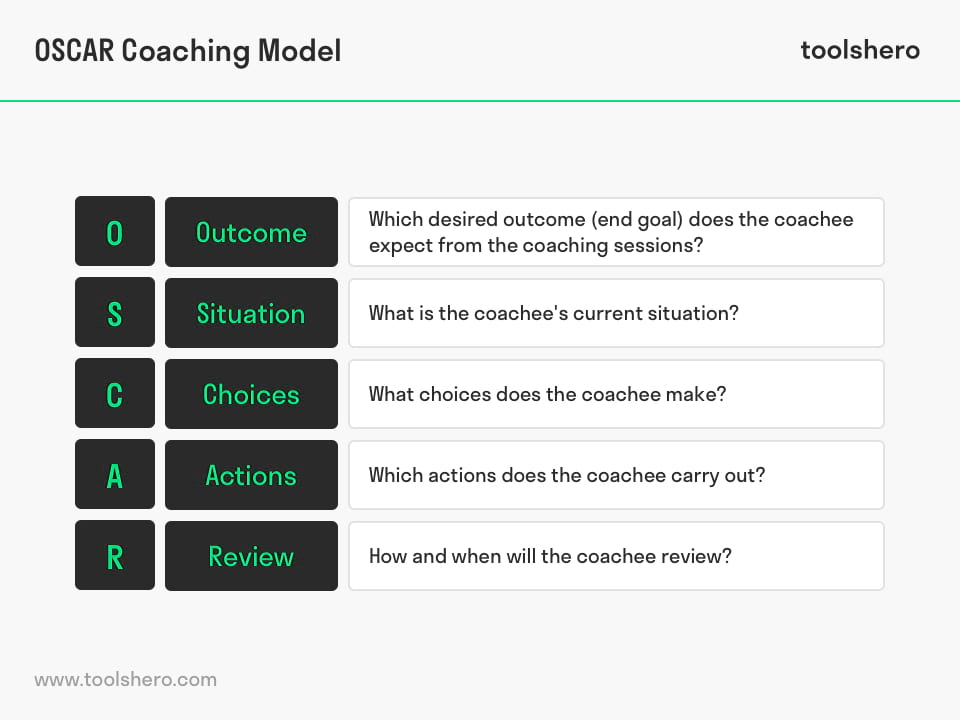OSCAR Coaching Model

OSCAR Coaching Model: this article provides a practical explanation of the OSCAR Coaching Model. After reading, you’ll understand the basics of this powerful management tool. This article also contains a downloadable and editable OSCAR Coaching Model questions template.
What is the OSCAR Coaching Model?
In coaching, it’s about getting the one who is being coached (the coachee) to find self-insight and awareness. There are several models that are often deployed and used in coaching, of which the GROW model is considered the most popular. GROW stands for Goal, Reality, Options, and Will.
The OSCAR model is derived from this. The OSCAR Coaching Model is a popular tool in workplace coaching. Its name is also an acronym, which stands for Outcome, Situation, Choices, Actions, and Review.
It was formulated in 2002 by British coaches and trainers Andrew Gilbert and Karen Whittleworth.
Their goal is to offer managers a way to come up with a good development style for coaching, which will benefit both the company as a whole and a department. The model allows managers to develop their team’s skills and knowledge even further.
Goal of the OSCAR Coaching Model
The OSCAR Model is a solution-oriented coaching method. It is not aimed, however, at finding out the causes of certain behaviour, anxiety, or failure.
The OSCAR Coaching Model takes as its starting point the employee’s (coachee’s) desired situation. By means of this method, the employee is able to shape this desired situation on their own.
The goal of the model is to help managers increase and improve their employees’ performance and professional efficiency. It is important here that the employee should be responsible for their own learning process.
The employee lists the goals, which will eventually have a motivating effect, themselves. The manager guides this process from their coaching role.
In addition, the manager will, together with the employee, check to make sure the goal set is actually feasible. The employee’s expertise forms the basis of this form of coaching. Hence, the OSCAR model is applied in virtually all personal development situations.
The OSCAR Coaching Model offers support
The power of the OSCAR Coaching Model lies in the fact that the coachee (employee) is given all possible space to decide how to develop themselves. In general, career counselling interviews are considered to involve an autocratic approach of the employee by the manager.
Within the OSCAR Coaching Model, it’s about the support given to the employee by the manager. The short-term and long-term development of employees should be encouraged by the manager. The employee is now being guided to take the reins in their own development.
If desired, the OSCAR model can be included in the regularly recurring performance interviews with staff. In that case, the manager has the option of monitoring all individual performances and progress, and stimulate employees where they get stuck.
It’s important for the manager, in their role as a coach, to understand, fulfil, and apply all parts of the OSCAR model:
Outcome: which desired outcome (end goal) does the coachee expect from the coaching sessions?
First of all, it should be clear what the employee wants to be coached on. The ‘coaching demand’ should, of course, be work-related. Perhaps the employee is afraid to express their opinion in the presence of employees of other departments.
Basically, they have difficulty speaking in front of a large audience. This is the problem behind their issue. In this case, the outcome is ‘being able to speak well and clearly in front of a large audience’. If the employee is a sales professional, this outcome is relevant to their work.
After all, they are expected to inform multiple departments at the same time about new sales agreements and their consequences for the entire organisation. In consultation with their manager in the role of coach, the employee will formulate their outcome by themselves.
As soon as the manager does this for them, the employee will be able to distance themselves from it and stop identifying with the desired outcome. The manager stimulates the coachee. This can be done, among other things, by asking what things will look like when their goal (outcome) has been achieved.
Situation: what is the coachee’s current situation?
Apart from the employee’s (working) situation, which includes their qualifications, skills, knowledge level, tasks within the job, and expertise, this also involves the employee’s feeling. Within this part of the OSCAR Coaching Model, the manager will need to carefully consider this because this feeling is a key to the problem faced by the employee.
For example, the sales professional will likely respond that they feel insecure, get nervous in front of a large audience, and feels constricted, after which they would want to run away more than anything. This is relevant information for the coach when it comes to help their coachee towards possible actions.
It’s the managers task to get the employee to be aware of their own situation. Apart from that, they could also ask what influence this has on the rest of the employee’s life.
Choices: what choices does the coachee make?
This part of the OSCAR Coaching Model involves not only asking the coachee for their choices, but also work together with them to investigate the possible positive and negative consequences of these choices. The employee is stimulated to think carefully about various ways to achieve the outcome.
For the sales professional, it may be an option to take public speaking classes. By looking intensively at the pros and cons, the employee will eventually be able to make their own choice. Other possibilities may be discussed in addition, after which the coachee decides which choice will lead to the best result.
Actions: which actions does the coachee carry out?
After the various choices are considered, the manager will stimulate the employee to carry out actual actions. What are the next steps in the chosen process? The actions may become clearer by formulating them as SMART goals: specific, measurable, attainable, realistic, and timely.
In the case where the sales professor chooses to take public speaking classes, he is aiming at a three-day training in which he follows an intensive course with a maximum of ten participants. He can decide when he starts by himself, and he chooses three consecutive days in September.
The training programme teaches him that he is expected to give many short presentations. He can use his own material. In between the training days, he is given homework assignments that he has to make at work.
The sales meeting is planned for the first Monday in October, and his goal is to lead this entire meeting. It is also the case, however, that each action the employee wants to undertake should be sufficiently motivating to them. The manager would do well to plan coaching sessions in the interim and ask the employee about the course of the process. The employee remains responsible for their own choices at all times.
Review: how and when will the coachee review?
At the actions stage, it is already very important to plan moments for the manager and the coachee to look at how the process is unfolding together. Review is very important here; it’s not only about what went well. It is also interesting to discuss what did not go well, in order to let the coachee gain insight into their own actions.
‘What went wrong’, ‘how did that happen’, ‘what was the result’, ‘what could you have done differently’, and ‘how did this feel’ are some questions that could be asked in this final phase. Should actions remain ineffective, the outcome may be revised or adjusted and the manager can offer help.
Mainly, an eye should be kept on the employee’s remaining motivated to attain the goal set by themselves.
OSCAR Coaching Model questions template
Use this OSCAR Coaching Model template to use during a coaching session or its preparation. Available as an editable template.
Download the OSCAR Coaching Model questions template
This template is exclusively for our paying Toolshero members. Click here to see if a membership is something for you!Now it’s your turn
What do you think? Do you recognize the explanation of the OSCAR coaching model? What are your experiences with this solution-oriented coaching method? Does this form of coaching give the coached employees sufficient support to achieve the desired situation?
Share your experience and knowledge in the comments box below.
More information
- Cope, M. (2007). The Seven Cs of Coaching: The Definitive Guide to Collaborative Coaching. Great Britain: Pearson Education Limited.
Danielson C 2007. The many faces of - Gilbert, A., & Whittleworth, K. (2009). The Oscar Coaching Model. Lulu. com.
- Mink, O., Owen, K., & Mink, B. (1993). Developing high performance people: The art of coaching. Basic Books.
How to cite this article:
Mulder, P. (2019). OSCAR Coaching Model. Retrieved [insert date] from Toolshero: https://www.toolshero.com/management/oscar-coaching-model/
Published on: 11/06/2019 | Last update: 03/25/2022
Add a link to this page on your website:
<a href=”https://www.toolshero.com/management/oscar-coaching-model/”>Toolshero: OSCAR Coaching Model</a>













